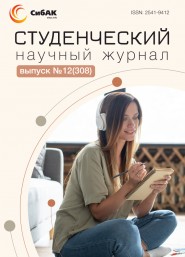Статья опубликована в рамках: Научного журнала «Студенческий» № 12(308)
Рубрика журнала: Педагогика
Скачать книгу(-и): скачать журнал часть 1, скачать журнал часть 2, скачать журнал часть 3, скачать журнал часть 4, скачать журнал часть 5, скачать журнал часть 6, скачать журнал часть 7
INTEGRATION OF INFORMATION AND COMMUNICATION TECHNOLOGIES INTO THE EDUCATIONAL PROCESS IN MATHEMATICS
ABSTRACT
The article discusses the problem of using ICT in mathematics lessons. The impact of ICT on the cognitive activity of schoolchildren and on their motivation is also analyzed. The article presents new teacher opportunities in teaching mathematics.
Keywords: information and communication technologies, education, mathematics, informatization, multimedia technologies.
The world is in a state of constant, dynamic development. This change affects all areas of life, and education is no exception. Children who are more adaptable adapt faster to new realities, unlike adults, whose established views and habits often become an obstacle to mastering innovations. This difference in the perception of change is especially noticeable in the educational process, where teachers face the need for constant professional growth and updating methodological approaches. They are the link between the ever-changing world and the younger generation, so their ability to keep up with the times is crucial for the successful transfer of knowledge and the formation of well-rounded personalities.
Modern education is undergoing a period of fundamental transformations due to the rapid development of information and communication technologies (ICT). ICT has become firmly embedded in all areas of our lives, and education is no exception. They offer unprecedented opportunities for the intensification and modernization of traditional teaching methods, allowing for the creation of interactive and entertaining educational environments.
Traditional teaching methods, effective in the past, are increasingly facing the problem of student motivation in modern conditions. Surrounded by a flood of information and a variety of gadgets, children demand new approaches to learning that would match their interests and learning style. This situation is especially relevant in subjects such as mathematics, where the high workload and abstract nature of the material often lead to a decrease in interest and a deterioration in academic performance. Teachers are faced with the need not only to explain complex mathematical concepts, but also to keep students' attention, maintain their motivation and stimulate them to study the subject independently [1].
In this situation, ICT provides teachers with a powerful tool to improve learning effectiveness. The use of ICT contributes to the activation of cognitive activity of students, turning passive perception of information into active participation in the learning process [2]. The research conducted by Shchukina G. V. and Bubnova N.O. confirms the positive impact of ICT on the cognitive and creative activity of students. The results of the study showed that the use of ICT leads to an increase in the level of cognitive activity, promotes the development of creative potential and improves the assimilation of educational material [3].
Technology significantly boosts teaching effectiveness by [2]:
- Streamlining Teacher Workload: ICT automates tasks like creating materials, grading assignments, and administering tests, freeing up teachers' time.
- Enhancing Content Delivery: ICT enables teachers to present information in engaging ways using multimedia, simulations, and visual aids, making learning more appealing and easier to grasp.
- Personalizing Learning: Digital tools allow teachers to tailor assignments to individual student needs and abilities, promoting differentiated instruction.
- Improving Feedback Mechanisms: Online assessments and surveys provide immediate insights into student understanding, enabling timely adjustments to teaching strategies.
- Expanding Learning Resources: ICT provides access to a wealth of supplementary materials like videos, interactive games, and online resources, broadening students' knowledge and sparking their interest.
- Making Lessons More Engaging: The variety of activities facilitated by ICT keeps lessons dynamic and prevents student boredom, leading to better learning outcomes.
- Developing Communication Skills: ICT fosters collaboration and communication through online discussions, group projects, and teamwork, enhancing students' interpersonal skills.
In conclusion, the transformative impact of Information and Communication Technologies (ICT) on modern education is undeniable. ICT offers educators a powerful toolkit to craft engaging and effective lessons. These tools can cater to diverse learning styles, providing personalized instruction and immediate feedback, a key element often lacking in large classroom settings.
References:
- Aleshkina, O.V. The use of information technologies in the mathematics lesson / O.V. Aleshkina, N.G. Turusova // Young scientist. - 2016. – No. 15. – pp. 435-437.
- Kalinina, I.V. The use of information and communication technologies in the teaching of mathematics / I.V. Kalinina // Modern information technologies. Theory and practice. - 2015. – No. 7. – pp. 122-125.
- Shchukina, G.V. Information technologies in the educational process of secondary schools in mathematics lessons / G.V. Shchukina, N.O. Bubnova // Mathematical education in schools and universities: innovations in the information space. - 2018. – pp. 143-147.


Оставить комментарий